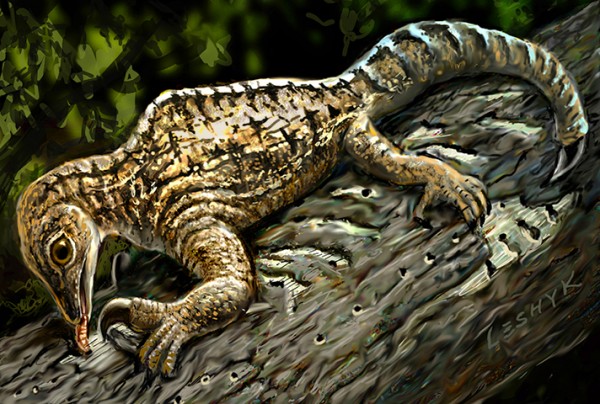By Ana Verayo, | October 02, 2016

In this illustration set 212 million years ago in what is today New Mexico, a Drepanosaurus rips away tree bark with its massive claw and powerful arm.
Scientists have uncovered 212 million years old fossils belonging to an extinct reptile that had bizarrely shaped arms, revealing interesting clues about the evolution of limbs in four-legged animals.
A team from Yale University analyzed fossils of a prehistoric reptile known as the drepanosaurus that can be described as a "chameleon and anteater hybrid." These fossilized remains were found on a site in Ghost Ranch, New Mexico.
Like Us on Facebook
Scientists examined the bone structure and found out that the animal's limbs were unlike any other reptile species during that time. According to the lead author of the study, Adam Pritchard of Yale University, this ancient animal stretches the evolutionary bounds of limbs of four-footed animals.
These fossilized remains revealed that the reptile's two arm bones--the radius and ulna--apparently possessed different sizes. This has not been observed in any tetrapods or four-limbed animals.
Pritchard says that the drepanosaurus appears to be a chameleon and anteater hybrid which is odd for that time, as it possessed a unique forelimb.
This new finding is particularly scientifically significant due to the animal's unusual front arms. This is considered as a unique evolutionary case as the structures that link the bones and forelimbs have remained "largely unchanged" over the history of tetrapoda, spanning 375 million years.
One of the unusual features of the drepanosaurus' limbs is a single long claw found on one of its fingers.
Scientists consider this as crucial evidence of how this creature played a "specialized, modern ecological role" during the Triassic period, some 200 million years ago.
This new study has been published in the journal Current Biology.
-
Use of Coronavirus Pandemic Drones Raises Privacy Concerns: Drones Spread Fear, Local Officials Say

-
Coronavirus Hampers The Delivery Of Lockheed Martin F-35 Stealth Fighters For 2020

-
Instagram Speeds Up Plans to Add Account Memorialization Feature Due to COVID-19 Deaths

-
NASA: Perseverance Plans to Bring 'Mars Rock' to Earth in 2031

-
600 Dead And 3,000 In The Hospital as Iranians Believed Drinking High-Concentrations of Alcohol Can Cure The Coronavirus

-
600 Dead And 3,000 In The Hospital as Iranians Believed Drinking High-Concentrations of Alcohol Can Cure The Coronavirus

-
COVID-19: Doctors, Nurses Use Virtual Reality to Learn New Skills in Treating Coronavirus Patients







